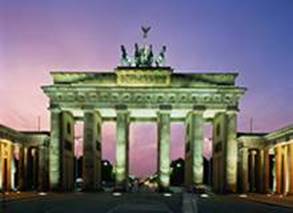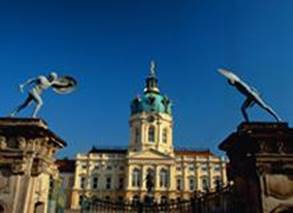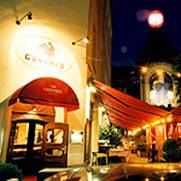5.Palace Hotel ( Budapester strasse 45)
This luxury 5-star city hotel presents 282 individually decorated rooms, including 32 suites about 55 - 225 sqm. Cable TV, refrigerated mini bar, trouser press, soundproofed windows and further extras belong to our standard. Its suites are appointed with marble bathrooms, exclusive hifi, as well as whirlpool and large dressing rooms. The elegant banqueting floors offer 12 different function rooms that can be extended to accommodate 10 - 700 persons as well as 5 banquet rooms in the adjoining Business Centre. Breakfast restaurant "Bon Dia", "Lounge" and "Sam's Bar" offering snacks and cocktails. Michelin-rated-Restaurant "First Floor" with chef Mathias Buchholz, Cafe-Restaurant "Tiffany's" and the rustic restaurant "Alt- Nurnberg" in the bordering Europa-Center. Money exchange, room service, laundry- and shoe cleaning service. Admission free to the "Thermen am Europa-Center", a large health spa with sauna and swimming pool.
First-class Hotels
Art hotel Sorat (Joachimstaler Strasse 28-29) – Art and accommodation: the Wolf Vostell designer furniture sculptures make each room a unique experience.
Avantgarde ( Kurfurstendamm 15) – Neo-Baroque house with huge rooms decorated with stucco mouldings.
Artemisia (Branderburgishe Strasse 18) – tiny, attractively decorated hotel reserved exclusively for women.
Dom Hotel ( Mohrenstrasse 30, Mitte) – fine modern hotel overlooking the most beautifull square in the city: the Platz der Academy.
Mondial (Kurfurstendamm 47) – spacious rooms. The entire hotel is designed for use by handicapped.
Hotels & Pensions.
Alpina (Trabener Strasse 3) – small villa with gardennear the Grunewald S-Bahn Station.
Kreuzberg ( Grossbeerenstrasse 64) – for young, undemanding guests.
Savoy ( Meinekestrasse 4) – Small but nice.
Terminus (Fasanenstrasse 48) – neither plush nor dingy.
Transit (Hagelberger Strasse 53-54) – Charming hotel for young people who care more for atmosphere than luxury.
Youth accommodation
Jugendherberge Bayernalee
(youth hostel) – Bayernalee 36
Jugendgastehaus am Wannsee
(youth guest house) – Badeweg 1
Jugendgastehaus BERLIN
(youth guest house) – Kluckstrasse 3
Jugendgastehausam Zoo
(youth guest house) – Hardenbergstrasse 9a
Jugendtouristenhotel
(youth guest house) – Franz-Mett-Strasse 7
5.2. Sightseeing in Berlin
A) The Brandenburg Gate (Brandenburger Tor)

The Brandenburg gate is the unquestionable symbol of Berlin and is now regarded as one of the greatest symbols of German unity. It is the last remaining gate of the Berlin Wall and marks the western end of the famous Unter den Linden Boulevard. The statue on top of the arch represents Nike driving her chariot to victory towards the West.
B) Museum Island (Museumsinsel)
The Berlin Museumsinsel is a unique ensemble of museum buildings that illustrate the evolution of modern museum design over more than a century. The museums include The National Gallery, The Old Museum (Altes Museum), The Pergamon Museum and The Bode Museum.
The National Galerie is an ultra-modern building built in the 1960s. The museum collection specialises in works from the 19th and 20th centuries as well as international contemporary art. The National Galerie is famous for its collection of French impressionists.
The Old Museum houses an amazing collection of 18th, 19th and early 20th-century paintings and statues. Any prominent artist you can think of it probably featured here.
The Pergamon Museum is immense. It is divided into five sections: the Antiquities Collection, the Middle East Museum, the Islamic Museum, the Far East Collection, and the Museum of Popular Art. A few days is needed to properly explore it.
The Bode Museum's original collection of Egyptian artifacts was very badly affected by World War II. However, there are outstanding exhibits of Byzantine and early Christian relics on show.
B) The Tiergarten

The Tiergarten is often referred to as Berlin’s green heart. Originally a hunting reserve for royalty, landscape architect Peter Joseph Lenne turned the Tiergarten into a beautiful city park in 1742. During World War II many of the trees were cut for firewood and the pristine lawns were turned into vegetable gardens to feed the populace of Berlin. Heavy bombing then damaged much of the rest of the park. The present-day plantings took place just after the war and today the beautifully lush Tiergarten is a popular place with Berliners and, to the surprise of many tourists, nude sunbathing is permitted throughout the park. The park is over 412-acres and it stretches for 1.75 miles west from the Brandenburg Gate.
D) The Berlin Wall
If you want to see what remains of the infamous Berlin Wall head down Charlottenstrasse and then west along Leipzigerstrasse. There you can see one of the best examples of what remains of the Wall.
E) The Berlin Radio Tower
The Berlin Radio Tower was built in 1924 for the Third German Broadcasting Exhibition. Standing at 138-meters high, this steel-latticed tower is a fantastic viewing point with panoramic bird’s-eye views of the city. An elevator takes you to the observation deck at 125 meters to admire the vista. There is a restaurant at the 55-meter level.
F) The Charlottenburg Palace (Schloss Charlottenburg)

The Charlottenburg Palace is the oldest surviving Prussian palace in Germany. Building began in 1695 and was completed in 1790. There are 70 rooms and corridors crammed full of ornate furnishings and Watteau paintings. The east wing houses an incredible collection of romanticist paintings while the west wing houses a collection of ancient and prehistoric art and artifacts. Take a guided tour of the royal apartments and then stroll through the formal gardens that surround the palace.
G) The Reichstag
The Reichstag, built in 1884-94, has witnessed many of the key moments in 20th century German history. It has seen the Proclamation of the German Republic in 1918, endured a burning in 1933, a storming in 1945 by Russian troops and German Reunification in 1990. Since its renovation in 1999, it has housed the Bundestag (Parliament).
H) Soviet War Memorial (Treptower Park)
Treptower Park houses a very sobering monument to the Soviet soldiers who died fighting Hitler. The park also contains a mass grave for the 5,000 soldiers killed in action. Walk the tree-lined avenue to see a statue of Mother Russia crying for her dead children. There are huge white stone reliefs set up in a manner not unlike the Stations of the Cross. They bear quotations from Stalin and depict how the Soviets won out against Fascism. At the far end of the park there is a massive statue of a heroic Soviet soldier clutching a child in one arm and smashing a swastika with the other.
I) The Jewish Quarter
The Scheunenviertel (Stable Quarter) is both Berlin's newest hot spot and one of its oldest areas. It was originally founded in the 17th century outside the medieval city walls. It survived Allied bombing raids and the Red Army's assault on the city. Recently, the quarter’s old buildings are being reincarnated as trendy bars, cafes, restaurants, and galleries. It is lively, trendy and bohemian and well worth a visit.
5.3. Eat, Drink, Nightlife
Berlin offers a wide range of possibilities to go out. Restaurants, Pubs and clubs of all kind and for every gusto invite you. Many places and streets are perfect night walks because one restaurant is here next to the other.
Many restaurants invite you to discover the delicacies of Berlin's cuisine. In a cosy ambiance you can savour the regional specialities and discover the variety of typical food along the meetballs (Bouletten) and Berliner Weiße (beer with juice).
The whole world is at home in Berlin. Restaurants offer food from around the world, from Argentina to Zimbabwe, folkloristic or exclusive. You are at the right place in Berlin to go on a culinary journey around the world or to discover really particular food.


Savigny-Platz
Night owls with stamina can also give their undivided attention to the interesting range of pubs around Savignyplatz in Charlottenburg. The area consist of a great number of restaurants and bars where everyone can meet the stars of television or Berlin's culture and political scene. Here is the melting pot that combines symbolically the former west and the new centre to a harmonic construction.
Pariser Straße and Ludwigkirchplatz
Especially the younger crowd is attracted to the Pariser Straße. At this location you will find taverns, bars, American diners, Mexican restaurants and very modern and stylish discos. During the summer life concentrates on the street in form of many chairs and tables that invite us to rest. In the middle of this street the well-maintained Ludwigkirchplatz with its rich areas of green providing a relaxing shadow is located.
The Winterfeldtplatz and Schöneber
The Winterfeldtplatz is the location of a frequently visited market. In the numerous taverns and bars, plenty of customers, tourists and locals meet each other. The scene is uncomplicated and open minded, also due to the presence of Berlin's gay population.
In Goltzstraße the Schönebergers meet in places such as the Café M, Lux or one of the numerous Indian snack bars. Between Schöneberg and Tiergarten the 90° is still an up-to-date party location. But the Latinamerican Clubs El Barrio or the Caracas Bar invite for a visit as well.
Conclusion.
Germany is among the most attractive countries for tourists because it has developed tourist and hospitality industry. In every city or even in the country tourists have an opportunity to find accommodation and to taste the national dishes. And there are everywhere numerous places of interest in Germany.
Every year a lot of tourists visit Germany to see its amazing and outstanding sightseeing. There is no doubt that tourists visited Germany wouldn’t be disappointed.
L iterature
1.Western Europe on a shoestring.
2.Berlin. Insight pocket guide.
Sites
1. www.berlin-tourist-information
2. www.germany-tourism.de
3. www.lonelyplanet
29-04-2015, 04:24
